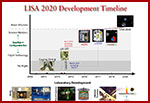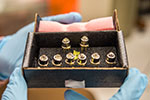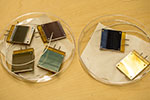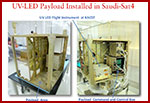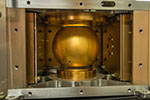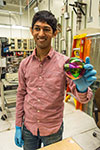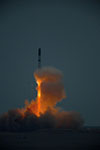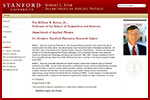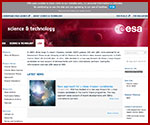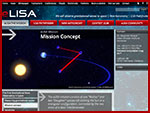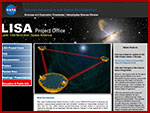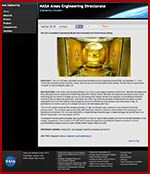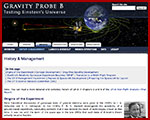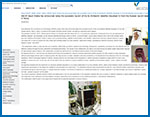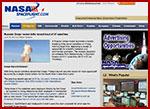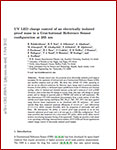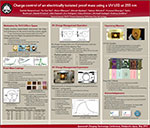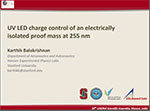
The UV-LED Experiment — A First Step Towards LISA 2020
HEPL PhD Candidate’s Charge-Control Experiment is Flight Certified at NASA Ames, Integrated into a Saudi Arabian Satellite and Launched into Orbit Aboard a Russian-Ukrainian Rocket
Given the current political state of the world, you might think that the headline above describes a doctoral candidate’s pipe dream. However, back on June 19, 2014, this satellite launch event actually happened!
Welcome to Graduate Research in Stanford’s Aero-Astro Engineering Department
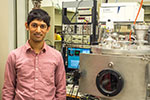
Aero-Astro PhD Student,
Karthik Balakrishnan, with
his UV-LED experiment
in Professor Robert Byer's
HEPL Lab
Karthik Balakrishnan is a doctoral student in the Aeronautics and Astronautics Department of Stanford’s School of Engineering. His research on charge control systems for satellite guidance is sponsored by HEPL and the Center for Excellence in Aeronautics and Astronautics (a collaboration between Stanford and the King Abdulaziz City for Science and Technology in Saudi Arabia), and it is being carried out in the laboratory of Robert Byer, Professor of Lasers and Optics in Stanford’s Department of Applied Physics. Professor Byer is also a former director of HEPL. Mr. Balakrishnan’s experimental apparatus uses low-power, ultraviolet frequency LEDs to remove electrostatic charge buildup from a baseball-sized, gold-coated sphere comprising the guidance control mechanism that enables a satellite to circle the Earth (or another planet or the Sun) as a gravitational reference sensor (GRS).
While an undergraduate at the University of California, San Diego, Mr. Balakrishnan majored in aerospace engineering, with a minor in physics. He also worked on launch vehicles for Aerospace Corporation in San Diego. In 2009, he applied and was accepted to the graduate program in Stanford’s Aeronautics & Astronautics (Aero-Astro) Engineering Department. During orientation in the spring of 2009, Mr. Balakrishnan toured several Stanford engineering/physics laboratories, including Professor Byer’s HEPL lab, where Aero-Astro Emeritus Professor, Dan DeBra and Senior Research Engineer, Sasha Buchman—the architect of the charge control system on the HEPL-spoonsored Gravity Probe B (GP-B) spacecraft, plus other former members of the GP-B research team—were working on plans for LISA 2020.
Professor Robert Byer’s Innovative LISA 2020 Research Collaboration
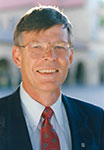
Professor Robert
Byer
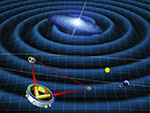
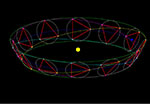
Artist's drawings of the
original LISA concept—a
trio of satellites each
containing two laser inter-
ferometers—orbiting the Sun
LISA 2020 is Professor Byer’s completely redefined version of the European Space Agency’s LISA (Laser Interferometer Space Antenna) experiment for addressing one of the “holy grails” of physics: the detection/proof of existence of gravitational waves, predicted by Albert Einstein in his 1916 general theory of relativity. The goal of the LISA experiment is to detect gravitational waves in outer space using a trio of identical satellites, spaced 5 million kilometers apart in a triangular formation, orbiting the Sun. Designed by the European Space Agency (ESA) in the 1980s, LISA became a joint ESA-NASA program in the 1990s, with a projected launch date of 2010. However, as time passed, LISA proved to be far more challenging and expensive than originally anticipated. The target launch date was moved to 2020, and later to 2034 or beyond. Furthermore, NASA pulled out of the LISA program in 2011, leaving development of the experiment solely with ESA.
In the years following the successful implementation of charge control on the Gravity Probe B spacecraft, which launched in 2004, with NASA’s budget for basic physics research in space shrinking, the costs of the LISA program escalating and the projected LISA launch date getting pushed further and further out, it became clear to Professor Byer that the LISA research program needed to undergo a paradigm shift. To this end, he and his colleagues set about defining a new Stanford-based, LISA experimental collaboration that is now called LISA 2020, and for which, Professor Byer is the Principal Investigator.
Professor Byer’s approach centers on developing an incremental series of cost-effective, cutting-edge experiments, testing and validating all the necessary components of the main LISA experiment, which was to be the final, culminating experiment of the series. Each of the incremental experiments was to be carried out in the course of a PhD thesis using small, modular satellites, off-the-shelf hardware whenever possible, strong graduate student participation and an international collaboration led by Stanford. Most important, Professor Byer and his team determined that it would be possible to launch this small-satellite version of the LISA experiment in an Earth orbit, rather than a solar orbit, incurring a small, but acceptable decrease in accuracy while gaining significant improvement in communications between Earth and the LISA 2020 satellite trio. The launch date for this new version of LISA was projected to be 2020—thus the name, LISA 2020. Not only would this revised paradigm for the LISA experiment be launched a number of years before the original ESA version of LISA, its cost would be less than one third the cost of the billion dollar plus ESA-LISA experiment.
Between 2004 and 2009, Professor Byer forged a three-way aerospace research collaboration between Stanford, NASA Ames Research Center and KACST. Dr. Simon “Pete” Worden, Director of NASA Ames, shared Professor Byer’s advocacy of incremental experiments using small satellites, and he readily agreed to make the NASA Ames space environmental testing lab available to the LISA 2020 collaboration. Likewise, in 2008, Dr. Turki Al Saud, Vice President for Research Institutes at KACST—and a Stanford Aero-Astro PhD—was already in the process of setting up a joint Stanford-KACST Center for Excellence in Aeronautics and Astronautics (CEAA), as well as providing funding for the final data analysis phase of the Gravity Probe B experiment. A division of KACST is responsible for building a series of modular Saudi Arabian satellites, and the Stanford-KACST CEAA could thus provide the satellites in which the incremental LISA 2020 experiments, flight certified at NASA Ames, would be installed and launched into orbit.
UV-LED Charge Control Experiment — The First Step Towards LISA 2020
By the spring of 2009, when Mr. Balakrishnan was touring the various engineering/physics labs at Stanford to decide on the focus of his graduate research, Professor Byer and his NASA Ames-KACST collaboration had defined a series of five incremental experiments, culminating with his scaled down version of LISA to be launched in 2020:
- UV-LED — A trailblazer (proof-of-concept) experiment to control the charge buildup on a GRS guidance control proof mass module using low-voltage, ultraviolet frequency LEDs. Launch date: June 19, 2014
- MGRS (Modular Gravitational Reference Sensor) — An aeronomy experiment performed in a 3-axis, small satellite GRS. Projected launch: 2016
- mSTAR (mini Space Time Asymmetry Research) — A Kennedy-Thorndike special relativity experiment in a small satellite GRS, comparing the length of a rod measured by a laser beam to the rate of a ticking clock. Projected launch: 2017
- mGRACE (mini Gravity Recovery and Climate Experiment) — A geodesy experiment using two small satellites, each equipped with a telescope and laser interferometer pointing at the telescope and laser interferometer on the other satellite. (The mGRACE satellite pair essentially comprises one arm of the LISA 2020 experiment.) Projected Launch: 2018
- LISA 2020 (Laser Interferometer Space Antenna 2020) — The Earth-orbiting version of the original LISA experiment, with three identical GRS satellites, spaced 1 million kilometers apart at the corners of an equilateral triangle, with each satellite having a pair of telescopes and laser interferometers, one focused on the satellite ahead and the other focused on the satellite behind. Projected Launch: 2020
Mr. Balakrishnan liked the LISA 2020 lab’s small systems, incremental approach. He was especially intrigued by the possibility that, as a graduate student, he could play a leading role in the research and development of guidance control hardware that might actually be launched in a small satellite. Moreover, he was highly motivated by the fact that his engineering work would serve the greater purpose of ultimately helping contribute to the advancement of scientific knowledge on gravitation. Thus, it didn’t take Mr. Balakrishnan long to make a decision about his graduate research focus at Stanford: he signed up to lead the work on the trailblazing UV-LED Charge Control experiment, the first increment in Professor Byer’s LISA 2020 program.
Gravitational Reference Sensors and the Need for Charge Control
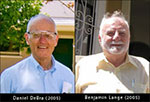
Stanford Pioneers of GRS
technology:
Emeritus
Professor Dan DeBra and
former Professor
Ben Lange
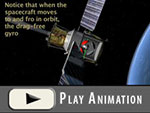
Gravity Probe B animation
showing the GRS feedback
system in the GP-B satellite
The essence of a gravitational reference sensor is that the sensor orbits the Earth (or the Sun or another planet) without any friction or drag. The sensor’s motion is affected only by the gravity of the object it is orbiting, and its orbital path traces out an almost perfect geodesic. For satellites orbiting Earth, and particularly those in low earth orbit (LEO) a few hundred miles above Earth’s surface, there is always some drag on the satellite caused by Earth’s atmosphere, solar pressure and other forces.
The concept of a GRS satellite was pioneered in the Stanford Aero-Astro Department in the 1960s by then graduate students Ben Lange and Dan DeBra, both of whom became Stanford Aero-Astro professors. In fact, [now] Emeritus Professor DeBra sits on Mr. Balakrishnan’s thesis committee, along with Dr. Buchman and Professor Steve Rock of the Stanford Aero-Astro Department. Furthermore, the Stanford Aero-Astro Department is the world’s leading authority on GRS systems and satellites. GRS satellite technology refers to a feedback system consisting of a satellite floating freely within an outer, shielding satellite. The inner satellite, called a “proof-mass,” is typically a small homogeneous object, such as a metallically coated quartz sphere, suspended in a housing within the outer satellite. The position of the outer satellite must be tightly controlled to prevent the proof mass from ever touching its housing. To accomplish this feedback system, the proof mass housing is equipped with sensors that precisely measure the position of the proof mass relative to its housing. Conversely, the outer satellite is equipped with a set of precision micro thrusters that automatically control its position, based on feedback from the proof mass housing sensors.
GRS guidance control of the LISA 2020 satellite will be accomplished by a feedback system in which the satellite “chases” a baseball-sized, spherical proof mass, electrostatically suspended in a housing within it. In order to maximize GRS performance, ensuring that the proof mass traces an almost perfect geodesic orbit around the Earth, small, residual forces acting on the proof mass must be minimized. One source of such residual forces is the buildup of electrostatic charges on the surface of the proof mass. The Gravity Probe B mission solved this problem using high-wattage, direct current (DC) ultraviolet arc lamps, mounted in the Experiment Control Unit (ECU) at the top end of the spacecraft and connected to each of GP-B’s four gyroscope housings with fiber-optic tubes. In order to remove electrostatic charge from GP-B’s spherical gyroscope rotors, the UV arc lamps were turned on, causing UV light to flow through the fiber-optic tubes and shine on the spinning rotor surfaces, disbursing the electrostatic charge.

Gravity Probe B charge
control using fiber optic
cables (left) vs LISA 2020
charge control using
UV-LEDs (right)
That solution worked fine for GP-B, in which the spacecraft was the size of a mini-van. There was plenty of room in the ECU to house the UV arc lamps and their large power supplies. Also, the GP-B gyroscope rotors only needed to be discharged a few times over the life of the mission, mostly during the checkout phase before collection of experimental data began. However, for LISA 2020, the high voltage arc lamp discharge solution is not feasible for several reasons:
- DC arc lamps are electronically noisy, generating a low-frequency hum that would interfere with the low-frequency gravitational wave signals being detected by the satellite.
- For LISA 2020, unlike GP-B, frequent proof mass discharge would be required throughout the experiment, and if a DC arc lamp charge control system were used, experimental data collection would have to be suspended whenever proof mass discharge was in progress.
- The fiber optic glass tubes used to carry the light from the arc lamps to the proof mass housing add extra complexity and cost to the housing and charge control system.
- DC arc lamps and their power supplies are typically too large to fit on a miniaturized satellite.
Thus, the first incremental step towards a LISA 2020 mission was the development of an alternating current (AC) UV charge control system that could be miniaturized and whose electronics would operate at high frequency, far from the frequency range of gravitational waves.
Building the Charge Control Module for a Small Satellite GRS Payload
The solution was ultraviolet frequency LEDs—specifically 5 volt AC, 3 milliamp, Aluminum gallium nitride (AlGaN) LEDs. The low-noise electronics for driving these LEDs fits on a postage-stamp sized circuit board, the LEDs themselves are tiny, and eight of them easily fit in a circular arrangement on one wall of the proof mass housing without the need for any fiber optic tubing. Most important, UV LEDs can be pulsed on and off throughout the mission without causing any interference with the experimental data.
From 2009 – 2012, Mr. Balakrishnan worked on this project, with assistance from other graduate students, including Andreas Zoellner (Mechanical Engineering), Eric Hultgren (Aero Astro Engineering) and Seiya Shimazu (Aero Astro Engineering). Also, several researchers from KACST, including Abdul Alfauwaz, Ahmad Aljadaan, Mohammed Almajeed, Muflih Alrufaydah, Salman Althubit and Homoud Aljabreen worked on various aspects of the project. During these years, Mr. Balakrishnan and his team had to address a number of issues, including:
- Finding off-the-shelf LEDs that could be used for the purpose of charge control in a space environment as well as an appropriate AC power source to drive them
- Determining what material the spherical proof mass should be made of, what size it needed to be, and the best metallic or alloy coating to use
- Figuring out how to measure the charge potential on this sphere
- Determining the best geometry for the charge control experiment—that is, how many LEDs would be required—taking failure and redundancy into account—and determining the positions of the LEDs relative to the sphere
- Determining which available LED lenses and packaging would work best in this experiment
During this four-year research and development period, Mr. Balakrishnan, his faculty and lab advisers, his team, and the team at NASA Ames addressed all of the above issues through an iterative trial-and-error process which involved wiring up prototype experiments on a portable cart at Stanford, driving the cart to NASA Ames in a mini-van, wheeling the car into a space environment testing lab at NASA Ames, and working with Ames lab technicians to run various tests. Based on feedback from the environmental testing, Mr. Balakrishnan and his team would make changes to the prototype, rerun tests at NASA Ames and repeat this process until the issue at hand was satisfactorily resolved.
By December 2012, Mr. Balakrishnan and his team delivered a flight-ready prototype to NASA Ames for final testing and flight certification. At that time, the plan was to integrate the charge control experiment into a KACST satellite to be launched in 2013. However, as is often the case with space research projects, some delays at various points in the process resulted in postponement. Finally, the launch was rescheduled for June 2014.
Mr. Balakrishnan was undaunted by these delays, and he was ecstatic when the Russian-Ukrainian rocket finally lifted off on June 19th. He commented:
It’s been an incredible experience and a dream come true to be able to be able to work on the UV-LED flight payload. Before I started graduate school at Stanford, I knew I wanted to work on satellite projects, but I never imagined that something that I worked on and helped develop would be launched into orbit. The successful delivery of the UV-LED payload and Saudi-Sat4 would have been impossible without the dedicated work of individuals at Stanford, KACST and NASA Ames. I look forward to the mission data and results, and the exciting impact it will have on the future of GRS guidance control and gravitational wave detection.
As of September 2014, checkout of the Saudi-Sat4 is nearing completion, and Mr. Balakrishnan is expecting to begin receiving data from his experiment, relayed from the satellite any day now. Assuming that the data confirms a successful test, we will be one step closer to the LISA 2020 experiment.
—Story by Bob Kahn, HEPL Communications Consultant & Webmaster
